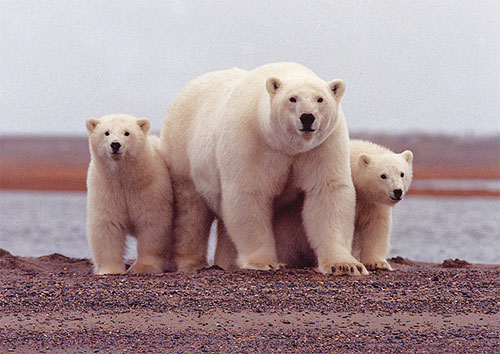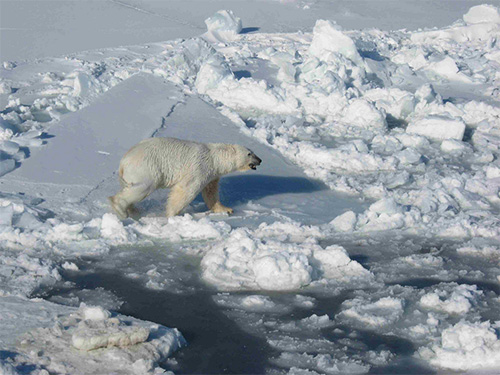
Would the Arctic still be the Arctic without the polar bear?Polar Bear Conservation Management Plan Draws Mixed Reaction from StateBy MARY KAUFFMAN
January 11, 2017
This final Conservation Management Plan (CMP) for the polar released this week by the U.S. Fish and Wildlife Service, outlines actions that will help this revered symbol of the Arctic persist in the wild in the near-term, while also acknowledging the primary threat to the bear will entail longer-term actions.
Polar Bear Mother With Cubs Along the Beaufort Sea: A polar bear mother watches carefully with her cubs along her side as their picture is taken. “This plan outlines the necessary actions and concrete commitments by the Service and our state, tribal, federal and international partners to protect polar bears in the near term,” said Greg Siekaniec, The Service’s Alaska Regional Director. “But make no mistake; without decisive action to address Arctic warming, the long-term fate of this species is uncertain.” The Polar Bear Conservation Management Plan, finalized Monday by the U.S. Fish and Wildlife Service, was received by the Alaska Department of Fish and Game with a mix of support and lingering disappointment. Developed with input from the department and other stakeholders, the plan serves as the USFWS’s guiding document for polar bear recovery under the Endangered Species Act. "We agree with many aspects of the plan, including recognition that the primary threat to polar bears is the loss of sea ice habitat brought on by climate change," said Alaska Division of Wildlife Conservation Director Bruce Dale. "We also strongly support the plan's goals to maintain sustainable subsistence harvest, appropriately manage human-bear interactions, and minimize restrictions to economic development and other activities." According to the U.S. Fish and Wildlife Service, the plan was developed by a diverse team of experts and partners and reflects input on the draft plan submitted during the 2015 public comment period. It calls for reducing human-bear conflicts, collaboratively managing subsistence harvest, protecting denning habitat, and minimizing the risk of contamination from oil spills. Most of these actions are already underway, in partnership with Alaska Native communities, nonprofit groups, and industry representatives who participated in the plan’s creation. The plan also calls for increased monitoring and research to determine whether the actions in the CMP are being effective or need to be modified. While the Conservation Management Plan focuses on management actions for the two U.S. subpopulations of polar bears that live off the coast of Alaska, it contributes to efforts to conserve polar bears in the other four range states of Norway, Greenland, Canada and Russia.
Male Polar Bear walking on pack ice near the open water.
Alaska Division of Wildlife Conservation Director Bruce Dale saod that the State of Alaska remains broadly opposed to the bears' 2008 worldwide listing by the USFWS as "threatened" under the ESA. "We don't believe Congress intended to have species with robust populations listed under the ESA," said Dale. The precedent of listing a species near its historical population baseline under the ESA has important implications for preempting state management authority over other fish and wildlife. Critical habitat designations accompanying the polar bear listing hamper development and when excessively broad are counterproductive to meaningful conservation measures. Approximately 187,157 square miles of Alaska lands and adjacent territorial and U.S. waters were designated critical habitat following the ESA listing. Alaska is home to 10-15 percent of the world's population of 22,000-31,000 polar bears. The state's two subpopulations, found in the Chukchi and Beaufort seas, are shared with Russia and Canada. Polar bears in the southern Beaufort Sea have been impacted by the diminishment of sea ice habitat and have declined from an estimated 1,500 bears in 2006 to about 900 in 2010. Insufficient data exists to determine the status of the Chukchi Sea subpopulation, but recent research indicates good body condition and reproduction, suggesting the potential for population growth despite declines in sea ice habitat in that region. Many of the actions included in today's polar bear plan were already in place prior to the plan's development and species listing. The conservation benefit from listing polar bears and developing a recovery plan is unclear. "Recovery planning is counterintuitive for robust populations," said Dale. "How do you recover a species with populations at or near their historical baseline numbers?" However, to the plan's credit, the state agrees that the ESA and the Marine Mammal Protection Act are not appropriate regulatory vehicles to address rising greenhouse emissions. The State of Alaska and many others challenged the USFWS polar bear listing in federal court as unwarranted, overly restrictive, or insufficiently protective. The court of appeals affirmed the threatened listing. Litigation continues over critical habitat, for which Alaska and others initially won, but USFWS won on appeal. The state and others recently requested review of the critical habitat decision by the U.S. Supreme Court. Polar bears are the largest carnivores and a unique symbol of the Arctic. Nineteen populations of polar bears are distributed in Alaska, Canada, Greenland, Norway, and Russia. The world wide population of polar bears is estimated to be 22,000-25,000 bears. Two populations occur in Alaska: the southern Beaufort Sea stock, shared with Canada; and the Bering Chukchi/Seas stock, shared with the Russian Federation. The U.S. Fish and Wildlife Service said they will continue to work with diverse partners to implement the Conservation Management Plan. The team will share information, identify priorities, leverage resources and adapt the plan according to new and emerging science and information.
On the Web:
Sources of News:
Representations of fact and opinions in comments posted are solely those of the individual posters and do not represent the opinions of Sitnews.
|
||

